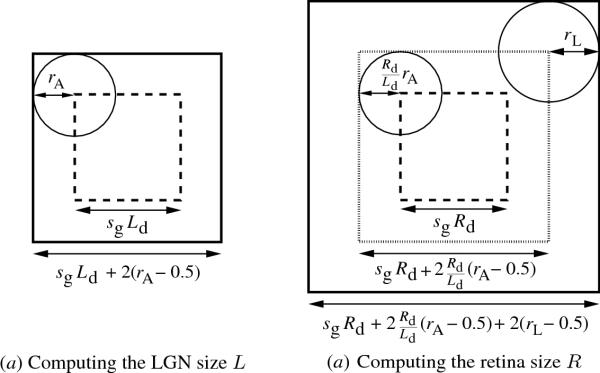
Click on the image to see a PDF version (for zooming in)
Fig. A.1. Mapping between neural sheets in LISSOM. In computing
the LGN size L and the retina size R (Table A.2), a buffer area is
added around the lower level sheet so that all neurons at the higher
level have complete receptive fields. (a) In the mapping from LGN to
V1, the outer square represents the LGN sheet, the dashed area maps
point-for-point to V1, and the circle represents the receptive field
of the top left V1 neuron. For instance, if sg = 8 and
Ld = 24, the dashed line encloses an area of 192 × 192 LGN
units (8 × 24 = 192). This area is extended on all sides by
rA - 0.5 units to make sure that all V1 neurons have
complete receptive fields. Thus, the LGN contains 204 × 204 neurons in
total (192 + 2 × 6 = 204). (b) The mapping from retina to V1 is formed
analogously, by extending the buffering down one more level. The outer
square represents the retina, the dotted area maps point-for-point to
the LGN, and the dashed area maps point-for-point to V1. The circle on
the right shows the receptive field of the top right LGN neuron and
the circle on the left represents the receptive field of the top left
V1 neuron, with its radius expressed in retinal units (hence the
factor Rd / Ld). For example, if Rd =
48, the dashed area is sg Rd = 8 × 48 = 384
retinal units wide and the dotted area 384 + 2 × 48/24 × 6 = 408
retinal units wide. For an LGN 24 radius of rL = 16.5, the
full retina therefore consists of 440 × 440 neurons (384 + 2 × 48/24 ×
6 + 2 × 16 = 440).
|